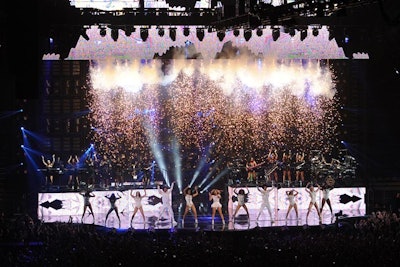
LeRoy “Roy” Bennett is among the industry’s top stage designers, having designed the stages for Super Bowl halftime performances by the likes of Bruno Mars, Beyoncé, and Paul McCartney, as well as other major concerts. Bennett’s creative collective, Seven Design Works, also includes Tobias Rylander and Cory FitzGerald.
Whether your events require elaborate stages or smaller-scale setups, consider Bennett’s top tips for staging.
1. Ground creative ideas
Yes, creativity is required to dream up imaginative stages. But there must be real-world solutions for executing ideas. “It's easy to come up with a great idea, but if it’s not logistically or fundamentally possible, then it’s useless,” says Bennett, who credits his ability to see both sides with his start as a technician in the business. “You have to understand logistics equally as much as [letting your mind exercise its] artistic and creative side. Understand your restrictions.” To that end, he says, let those boundary-defining restrictions—for instance a venue’s particular inconvenient specs—really inspire creativity.
2. Favor the live audience
For a massive show like the Super Bowl, the at-home viewing audience is far bigger—at 111.5 million this year—than the live audience in the stadium. But focusing first on the needs of the live audience will yield the best results for television, Web streaming, or whichever platform the secondary audience may be watching. “You have to think both about the television viewer because there’s more of them than there are in the stadium. But at the same time, you want to be able to stimulate the audience in the stadium, because they are portraying the vibe of the event [to the audience at home]. If you can stimulate a live audience, you’ll get a great show [for the cameras too]," he says.
3. Simplify
No matter how big and elaborate a stage set may appear to the audience, the key is to distill the components of the stage design down to the most basic elements possible in order to streamline the production and reduce the chances of conspicuous problems. “You need to design something in chunks or pieces," Bennett says. "The least number of pieces you have to bring out, the better. It’s faster that way, [key for fast-changing shows like the Super Bowl]. And the more intricate something is, the more you’re putting yourself at risk. Try to simplify down as much as possible."
4. Be flexible
Whether it’s to accommodate a venue’s ingress and egress points, or to acknowledge technical limitations, be prepared to change course. “Have an open mind, and say, ‘O.K., if we can’t do this, we’ll do that.’ Be able to creatively compromise. There’s a million ways to get to the end result. None of them are wrong,” he says.
5. Keep communication open
The technical team and the creative team working on a stage may sometimes feel their work is at odds—so open communication between all players is key. “There have been times when I've had a crew tell me, ‘I can’t do that,’ and I said, ‘I’ll do it myself’ [only to try and realize it couldn’t be done]. You have to have the understanding of what it takes for the crew to put a show together. Ultimately, I have the last say in a lot of stuff, but I realize I’m part of a team all here to make things happen," Bennett says.
6. Show appreciation
To that end, acknowledgement of the team’s efforts is the best way to keep the train running on track. “The trick to everything is surrounding yourself with the best team. They have to have faith in you," Bennett says. "You have to deliver for them at all times and make all their efforts worthwhile. If my crew doesn't feel their hard work paid off, then I failed. The crew should never feel invisible. Acknowledge what your team has done—even if it’s just making sure to say ‘thank you.’”
7. Use every show as a learning opportunity
No creative event professional wants to repeat him or herself from one show to the next. But by using the last show as a jumping-off point, planners can manipulate one good idea and make it even better with experience. “If I repeat myself, it’s [in the course of] taking something and twisting it into something else. What I did last time is an experiment [in service of] what I’m headed to. It’s a learning process," he says.
8. Focus on the fans
At its core, a live concert is about impacting fans—not merely an exercise of technical precision in a vacuum. Let the audience serve as the inspiration to keep pushing the creative boundaries. “One of the most memorable things I did was a show with Paul McCartney in Rome in front of the Coliseum for 500,000 people. That was an amazing experience," Bennett says. "Technically, I’ve done some fun stuff, but what it’s all about is moving people. Take them them out of their day-to-day lives and bring it in for a moment."














![For the after-party, Event Eleven built three 30-foot pagodas and hung 300 lanterns from the ceiling. They also brought in a 20-foot-tall bonsai tree and a variety of 30-foot red maples, along with other greenery and foliage. '[It all] helped create the organic atmosphere and helped transport guests into a gardenlike room,' said Schubert.](https://img.bizbash.com/files/base/bizbash/bzb/image/2024/02/Shogun.41_f.65dba8f23433b.png?auto=format%2Ccompress&fit=crop&h=112&q=70&w=112)




